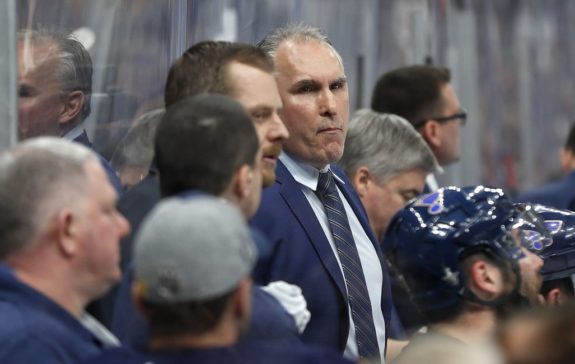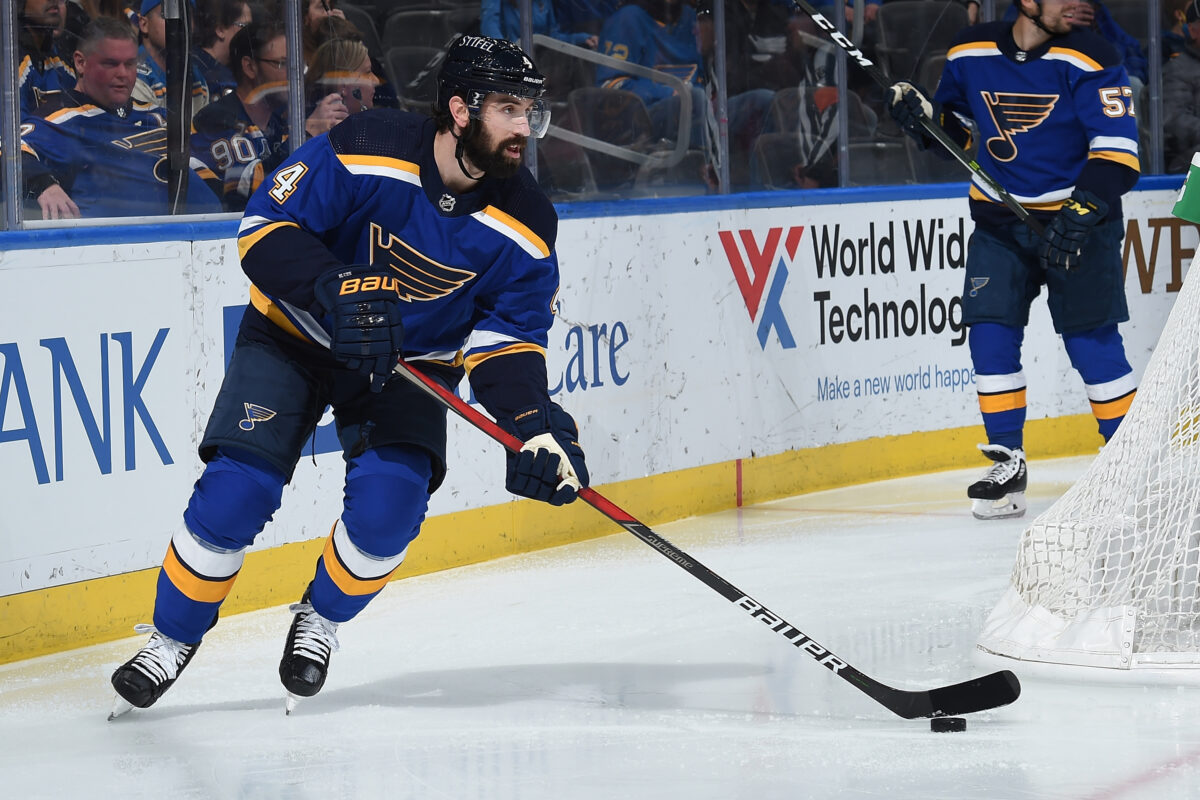After a six-game second-round exit in the 2022 Stanley Cup Playoffs, provided by the eventual Stanley Cup champions in the Colorado Avalanche, the St. Louis Blues approached October of the same year with playoff-certifiable ambiance and ambition. However, by March, two of their main pieces of a recent Cup-winning core, Ryan O’Reilly and Vladimir Tarasenko, were gone, with the Blues positioned well out of bounds in the Western Conference standings playoffs-wise. Injuries perhaps prevented the team from reaching the 100-plus point ceiling assigned to them in October 2022, but outstanding detriments in their on-ice operation were far more penalizing in the full 82-game scope; defensive instability and immobility served only paralyzing to a team otherwise well-directed on the ice.
Related: St. Louis Blues’ 2023-24 Lineup Projection
Defensive inadequacy is generally formed through different fashions across the league, but it is the Blues who perhaps fail to perform at even league-average qualities in almost every aspect of preventing offensive opportunities for the opposition. Below-average to near league-worst qualities in chances against per 60, and high-danger passes against per 60 (per AllThreeZones) are why the Blues in 2022-23 posted the sixth-worst expected goals percentage (per Evolving-Hockey) league-wide. A mark as poor as this simply cannot remain the same for the Blues, notable for their serial playoff appearances, to return to their playoff routine.
Lineup Projection and Discussion
Daily Faceoff’s most recent lineup projection foresees the Blues pitting the defensive core listed below when at full strength.
Nick Leddy – Colton Parayko
Torey Krug – Justin Faulk
Callen Rosen – Robert Bortuzzo
Now, this excludes an equally (or perhaps more) qualified right-handed shot in Marco Scandella and a left shot in Scott Perunovich, who are both likely to see some significant NHL time this season.
The lack of a coveted top-pair defender highlights the visual observation of this defensive core, although it is not necessarily novel for the club since the exit of Alex Pietrangelo. Aside from the middle pair, the backline of this team is particularly sluggish, often leaving them starkly vulnerable through high-danger areas of in-zone ice and opportunities for teams to threaten through the rush.
Deficiencies in Blues Defensive Schemes
For the Blues, defensive defects root from the natural dynamic within the offensive zone but are worsened by underlying qualities in their defenders. Namely, Craig Berube‘s employment of closely grounded play below the hash marks and behind the net intends to leverage the high offensive work rate and play creation proficiencies of his forwards through tightly-conducted puck movement, disengaging defenders from underlying threats across the rest of the offensive ice. Berube is also aware of the offensive ability within his defenders, utilizing this created space to penetrate into the weak side of the ice and create an additional attacking layer.

However, these offensive principles lack the safety valves necessary to adjust to mistakes, requiring very fine execution to avoid dangerous counterattacks. While this natural instability presented in this scheme is a risk high-end offensive teams may be willing to take into consideration their talent (especially in the modern game), the Blues are plagued at a far higher severity due to additional immobility in the backend.
Per AllThreeZones, the Blues are among the league-worst in not only controlled rushes rewarded to opponents each game but how often these rushes are denied by the backline. Essentially, the compactness of the Blues low in the offensive zone minimalizes their opportunity to support the play on the back-check, leaving an aging and sluggish defensive core to take on controlled rushes at a high frequency across each game, which is exacerbated further by the decision to employ Nick Leddy and Colton Parayko against top lines consistently.
In-zone defense only serves more issues for the Blues’ defensive play. They elect to press the play to one side of the ice, seeking to force a turnover and move the puck up ice quickly, which is often successful for the club. However, when this does fail, the Blues have to push up to defenders quickly, establishing gap advantages for defenders to use to advance and push the play to more dangerous ice. Man-on-man coverage low is notably ineffective for defenders lacking the speed and agility to maintain adequate defending distance with opposing forwards, allowing opposing teams to access the middle of the ice incredibly often.
Between each of these defects, inconsistency becomes the symptom of this defensive disease for the Blues; while they may lack the resources to cure it, they can certainly maintain it.
Approaching the Systematic Errors for the Blues
Adjusting Deployment
Unfortunately, Leddy and Parayko would be best suited for middle pair or even bottom pair minutes (which is not entirely obtainable due to the lack of depth on the roster as well) within the lineup. Between Leddy’s steady decline and Parayko’s physical damages due to injury, alongside the aforementioned byproduct of the Blues’ schemes holistically, the pair is not equipped to face the top lines of teams in the league, which are often incredibly active on the rush. Minutes against lower-quality competition would be the start of minimalizing these natural defects in their play, with more fundamental improvements having to be made teamwide.

Torey Krug and Justin Faulk may be similarly troubling as a top pair when discussing their own defensive struggles, but adjustments would likely be more effective given the more mobile nature of the two relative to that of Leddy and Parayko. In discussing changes in the bottom pair, choosing youthful speed in favor of a player such as Robert Bortuzzo may even be another option available in making some substantial improvement to the overall defensive results of the Blues.
Improving Defensive Zone Structure
St. Louis could explore making fundamental adjustments to their defensive zone structure, which would encompass more of the defensive zone. Placing the weakside winger closer to the lower slot directly would be the beginning basis for improving defensive zone results, allowing the winger to be more proactive and suffocate dangerous areas to an enhanced degree while also maintaining a valve for them to move up the ice quickly on a zone exit. In terms of play below the hash marks, a slight widening of the structure and conversion to a zone-based network could perhaps be beneficial for the slower nature of St. Louis’ defensive corps.
Developing Safety Valves
Electing to pull a defender back further in the offensive zone and activating more flexibility for the center-lane forward in the defensive zone is likely the most fruitful solution to preparing the Blues for rush attacks in an adequate manner. Not only does this keep the structure of the team in the offensive zone more proactive holistically, but it may even instill an additional layer into the Blues’ already potent offense. Both the high forward and the high defender could see a greater amount of time to make a play when receiving the puck, allowing the great play-creators of the Blues to utilize more ice and create plays into a greater flow of opportunity while wearing down the opposition, which could cascade to allowing them to maintain possession and utilize their surpluses in finishing plays more often. Through this, the Blues could limit the number of rushes seen per game and overall defensive zone time.
Playing to Strengths
Ultimately, the Blues will likely post below-average defensive results, but this may not be as problematic if they can minimalize their defensive zone defects while avoiding suffocating their octane offense from producing at the rates achieved in recent seasons. Craig Berube and the club will seek to leverage their strengths rather than averaging them to their weakness in a holistic sense. With regular season competition just over a week away, St. Louis has placed themselves favorably for a return to the postseason. With key systematic modifications, this return can be assured within the middle months of the season.
Otherwise, it is certainly possible that the Blues will be positioned similarly to last season in March again, forcing the club to sell for draft stock and younger assets again and bringing the club much closer to an immediate rebuilding state. Simply, St. Louis possesses far too high of a talent level to submit to these lows so soon, but a lack of proactivity internally may result in such occurring.
